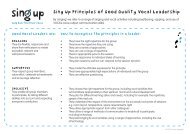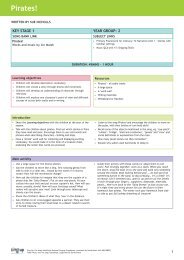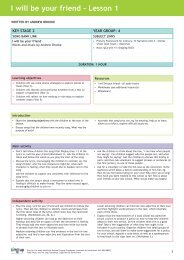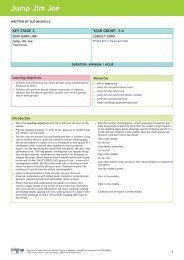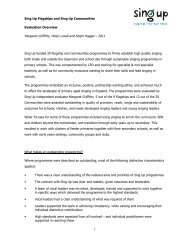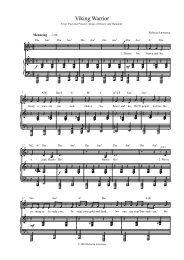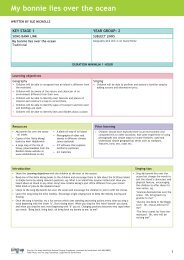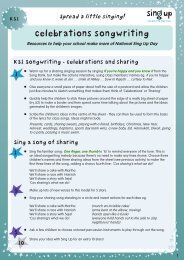Voice development over the lifespan - Sing Up
Voice development over the lifespan - Sing Up
Voice development over the lifespan - Sing Up
Create successful ePaper yourself
Turn your PDF publications into a flip-book with our unique Google optimized e-Paper software.
CHAPTER 4<br />
<strong>Sing</strong>ing technique<br />
• z Breathing: developing and maintaining effective and energised lower-abdominal breathing (see<br />
Chapter 5) is particularly beneficial at this stage. Technical aspects, such as onset and sustain, can be<br />
worked on, as can a variety of musical styles and <strong>the</strong>ir related vocal timbres.<br />
• z Breathiness: can be worked on effectively (see ‘Clear tone’ in Chapter 5).<br />
• z Register breaks: teenage girls often have a strong and well-developed lower range, but a<br />
comparatively weak and breathy upper range. They may try to avoid singing high notes, but <strong>the</strong>re are<br />
many ways in which register breaks can be worked on:<br />
• Lighten off <strong>the</strong> voice in <strong>the</strong> lower range and work on deconstriction (see ‘Avoiding constriction<br />
in <strong>the</strong> larynx’ in Chapter 5).<br />
• Explore upper pitches with clear and energised sounds using non-singing sounds (eg. by<br />
using <strong>the</strong> Siren warm-up from <strong>the</strong> <strong>Sing</strong> up <strong>Voice</strong> Box).<br />
• Blur <strong>the</strong> boundary, bringing <strong>the</strong> upper voice down below <strong>the</strong> pitch of <strong>the</strong> usual register<br />
change, and give <strong>the</strong> singer options of different voice qualities on <strong>the</strong> same pitch. It’s important<br />
for all singers to develop this movable register.<br />
<strong>Sing</strong>ing high notes can be an unfamiliar sensation, as it’s not a regular part of our everyday voice use.<br />
Girls may need to be encouraged to try it out as <strong>the</strong>y might think it sounds horrible! Play with noises and<br />
have fun; <strong>the</strong> laughing pupil will learn more easily than <strong>the</strong> anxious one.<br />
• z Repertoire: <strong>the</strong> repertoire possibilities begin to open out with <strong>the</strong> developing emotional and musical<br />
maturity of <strong>the</strong> singer, although adolescent girls still have limitations of <strong>the</strong> vocal extremes of loud and<br />
high. In general, repertoire written to be sung <strong>over</strong> a large orchestra is not suitable, even when it is sung<br />
with a piano. The phrases are often long and expansive, <strong>the</strong>re are more sustained higher pitches and<br />
<strong>the</strong> vocal timbre is generally fuller. There is much enjoyable repertoire of more modest demands which<br />
encourages <strong>development</strong> of a good, healthy and efficient singing technique.<br />
Adolescent boys’ voices<br />
Physical <strong>development</strong><br />
Male vocal <strong>development</strong> through puberty is best referred to as ‘changing’, as <strong>the</strong> term ‘breaking’ can be<br />
construed as a negative or destructive process.<br />
Boys’ larynxes grow primarily in <strong>the</strong> front-to-back direction, often forming <strong>the</strong> prominent Adam’s apple on<br />
<strong>the</strong> front of <strong>the</strong> neck. Within <strong>the</strong> larynx, <strong>the</strong> vocal folds increase in both length and thickness. This increased<br />
size means that <strong>the</strong>y vibrate at a lower frequency, hence <strong>the</strong> drop in speaking pitch.<br />
Although <strong>the</strong> changes are continual, paediatricians often refer to five phases of puberty, with growth in<br />
physique closely related to <strong>the</strong> voice lowering in pitch (see Diagram 5 on p9). The maximum change in pitch<br />
often occurs at <strong>the</strong> same time as <strong>the</strong> biggest growth spurt, between Phases 3 and 4.<br />
It is more reliable to judge <strong>the</strong> <strong>development</strong>al phase by <strong>the</strong> lower singing range and by <strong>the</strong> average<br />
spoken pitch. The upper pitch range can vary more between individuals.<br />
Assessment<br />
When working with adolescent boys, it’s crucial to assess which phase of vocal <strong>development</strong> <strong>the</strong>y’re in. Invite<br />
<strong>the</strong> child to recite an unexciting list (eg. months of <strong>the</strong> year) and work out where his average speaking note<br />
is on <strong>the</strong> piano. Then look at Diagram 5 to find out which phase he’s in. Remember that <strong>the</strong>se are based on<br />
averages and <strong>the</strong>re will be many individual variations.<br />
Occasionally you may come across a boy whose lowest singing note is not a third below his speaking<br />
pitch. This may be because he is artificially lowering his speaking voice in order to sound older (which is<br />
common in late developers). Alternatively, he might be holding his speaking voice up through trying to<br />
preserve a high singing voice. Any pushing down or holding up of <strong>the</strong> speaking pitch will result in vocal<br />
tension and is best discouraged.<br />
INSIDE THE VOICE www.singup.org 8



